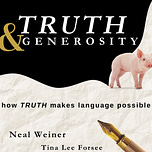“Relativism makes the unity of being a mere appearance while preserving the diversity of opinion. What I propose is the reverse: to make diversity of opinion the appearance and preserve the unity of being.”
News, Updates, Etc.:
You can customize which bits of the newsletter you receive by visiting your account at any time. My regular posts will continue to be free.
For a more in-depth comparison of the ancient and modern worldviews you can download my senior thesis on Plato and Descartes, which I’ve recently converted into ebook formats. Also available in PDF format. (Keep in mind I wrote this nearly 20 years ago):
Thanks for reading and/or listening!
—Neal and Tina
8
Trust and Doubt
THESE DAYS WE TEND to view knowledge as a special achievement; ignorance is our default condition. We think of the mind as something apart from the world, and the connections it makes to the world we call knowledge. We then ask: How can the mind know the world as it really is, apart from our minds? Is knowledge of the world in itself even possible?
For us, knowledge is a problem.
But suppose the mind and the world were not two separate things, but, as Aristotle put it, “That which thinks and that which is thought are the same.”
Ancient philosophers in the western tradition sought to answer the question of how the mind can fail to know its own object, how it is possible to be mistaken about the world.
For them, error was the problem.
The world we tend to take as reality, the tangible world of sense perception—the world we see, touch, taste and hear—Parmenides called a mere illusion. He insisted that reality was one, continuous, unchanging, uncreated, and indestructible, because to allow for anything less would be to accord non-being some sort of unthinkable existence:
You cannot say or even think non-being, because it is the same to think and to be.
Is is, but Is-not is not and cannot be.
Of course we wonder why Parmenides felt compelled to allow no gap between the mind and the world. Scholarly interpretation of these mysterious epigrams are various and ingenious, but, given that only a tiny amount of text survives, hardly decisive.
Perhaps Is is and Is-not is not was an early attempt to formulate the law of non-contradiction, that contradictory propositions cannot both be true in the same sense at the same time, except Parmenides failed to take time and relation into account. In his version, the denial of motion and plurality quickly follows, as does the impossibility of error. After all, error depends on mind failing to connect with reality, which presupposes the existence of the mind and the world as two disparate things. Whatever the correct interpretation, at the very least we can be sure that Parmenides believed in the unity of thought, speech, and being. For him, mind is wedded to truth—it cannot help but speak it.
What can we make of so outlandish a claim? Plato’s response was to find among the objects of thought something that exists in a shadowy and somewhat illusory way, something that in its very being points away from itself. Images do just that. If you ask me to describe the Mona Lisa and I tell you it’s a famous painting in a gallery in France, surely I have missed the point. At the very least I could have mentioned the mysterious woman and her haunting smile. After all, the image as such hardly matters. It’s what images are images of that matters.
The Plato of the Republic and the middle period took the existence of images as the answer to Parmenides’ problem of error. Plato then proceeded—albeit apologetically, in deference to ‘Father Parmenides'—to read the entire physical world not as an illusion, but as an image, or as he puts it, “a moving picture of eternity”. Plato thought of images as semi-actualities which lived in a realm of becoming and required the existence—in some mysterious sense of the word exist—of non-being, posited only out of necessity and only by a sort of “bastard reasoning”. So what are we to make of images mediating between reality and our knowledge of it?
Images are, taken in the negative sense, a distortion of reality, but there is a less frequently noted positive side as well. The image is, after all, an image of nothing less than reality. As such, it reveals reality, presents it, and serves as a kind of mediator between ourselves and a truth that is only darkly known. If ordinary speech is an image of the real, then it can be deceptive only to the extent that it is taken literally. The image is not reality, it is of reality, and to those who know this the image has great value, for it is nothing less than the road to truth.
Plato made room for error and in doing so placed between the world and our awareness of it a psychological veil, but it was the French philosopher, René Descartes (1596-1650), who turned the veil into an impenetrable wall. It wasn’t until modern times that the problem of error became the problem of knowledge as we know it. Sometimes called the ‘Father of Modern Philosophy’, his legacy of skepticism persists today.
Listen to this episode with a 7-day free trial
Subscribe to Philosophy and Fiction to listen to this post and get 7 days of free access to the full post archives.







